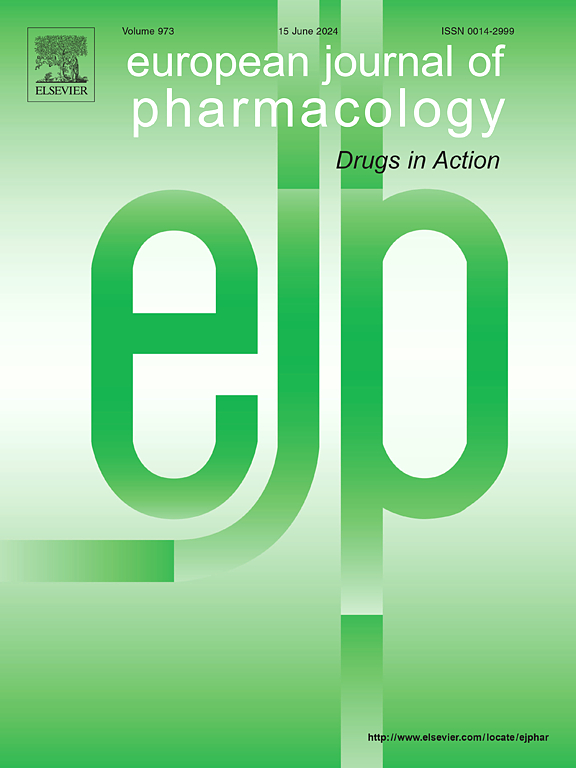Acacetin通过SIRT1-HMGB1通路抑制缺氧诱导的肺动脉平滑肌细胞增殖,逆转缺氧肺动脉高压
IF 4.2
3区 医学
Q1 PHARMACOLOGY & PHARMACY
引用次数: 0
摘要
低氧性肺动脉高压(HPH)以肺动脉压持续升高和血管重构为特征。本研究旨在探讨阿曲素对HPH的作用及其可能的分子机制。C57/BL6小鼠暴露于低压缺氧6周。在缺氧暴露第4周时,小鼠分别给予水溶性前药阿曲肽(5、10、20 mg/kg)或等量生理盐水再给药2周。进行血流动力学和病理组织学评估。培养原代肺动脉平滑肌细胞(PASMCs),观察阿卡乙素(0.3-3 μM)的抗增殖作用。在SIRT1 RNA干扰或不干扰的情况下,测定肺和/或培养PASMCs中sirtuin1 (SIRT1)乙酰化活性和表达以及高迁移率组盒1 (HMGB1)的分布。通过大分子对接和分子动力学模拟,探索阿卡乙酰素与SIRT1的潜在结合。结果表明,阿卡乙酰素前药可显著逆转HPH小鼠肺动脉压升高和血管重构,这与抑制SIRT1的降低和HMGB1的升高,抑制HMGB1核质易位有关。在培养的PASMCs中,acacetin抑制缺氧诱导的超增殖,逆转SIRT1的降低,抑制核质中HMGB1的易位和HMGB1的升高。沉默SIRT1消除了阿曲素的所有有益作用。这些结果表明,acacetin通过调节SIRT1-HMGB1信号传导抑制PASMC过度增殖,非常有效地逆转HPH,提示acacetin可能是治疗HPH患者的有希望的候选药物。本文章由计算机程序翻译,如有差异,请以英文原文为准。

Acacetin reverses hypoxic pulmonary hypertension by inhibiting hypoxia-induced proliferation of pulmonary artery smooth muscle cells via SIRT1-HMGB1 pathway
Hypoxic pulmonary hypertension (HPH) is characterized by sustained elevation of pulmonary arterial pressure and vascular remodeling. The present study is to investigate the efficacy of acacetin on HPH and its potential molecular mechanism. C57/BL6 mice were exposed to hypobaric hypoxia for six weeks. At 4th week of hypoxia exposure, mice were administrated with the water-soluble prodrug of acacetin (5, 10, 20 mg/kg) or equivalent normal saline for another two weeks. The haemodynamic and pathohistological assessment were performed. Primary pulmonary artery smooth muscle cells (PASMCs) were cultured to examine the anti-proliferation efficacy of acacetin (0.3–3 μM). The activity and expression of sirtuin1 (SIRT1) acetylation and distribution of high-mobility group box 1 (HMGB1) were determined in lungs and/or cultured PASMCs with or without RNA interference of SIRT1. Macromolecular docking and molecular dynamics simulation were done to explore the potential binding between acacetin and SIRT1. Results showed that acacetin prodrug significantly reversed the increased pulmonary pressure and vascular remodeling in HPH mice, which is associated with inhibiting the reduction in SIRT1 and the increase in HMGB1, and inhibiting the nucleocytoplasmic translocation of HMGB1. In cultured PASMCs, acacetin inhibited the hyper-proliferation induced by hypoxia, reversed the SIRT1 reduction and inhibited the nucleocytoplasmic translocation of HMGB1 and HMGB1 increase. Silencing SIRT1 abolished all the beneficial effects of acacetin. These results demonstrate that acacetin is very effective in reversing HPH by inhibiting PASMC hyper-proliferation via regulating SIRT1-HMGB1 signaling, suggesting that acacetin is likely a promising drug candidate for treating patients with HPH.
求助全文
通过发布文献求助,成功后即可免费获取论文全文。
去求助
来源期刊
CiteScore
9.00
自引率
0.00%
发文量
572
审稿时长
34 days
期刊介绍:
The European Journal of Pharmacology publishes research papers covering all aspects of experimental pharmacology with focus on the mechanism of action of structurally identified compounds affecting biological systems.
The scope includes:
Behavioural pharmacology
Neuropharmacology and analgesia
Cardiovascular pharmacology
Pulmonary, gastrointestinal and urogenital pharmacology
Endocrine pharmacology
Immunopharmacology and inflammation
Molecular and cellular pharmacology
Regenerative pharmacology
Biologicals and biotherapeutics
Translational pharmacology
Nutriceutical pharmacology.

 求助内容:
求助内容: 应助结果提醒方式:
应助结果提醒方式:


